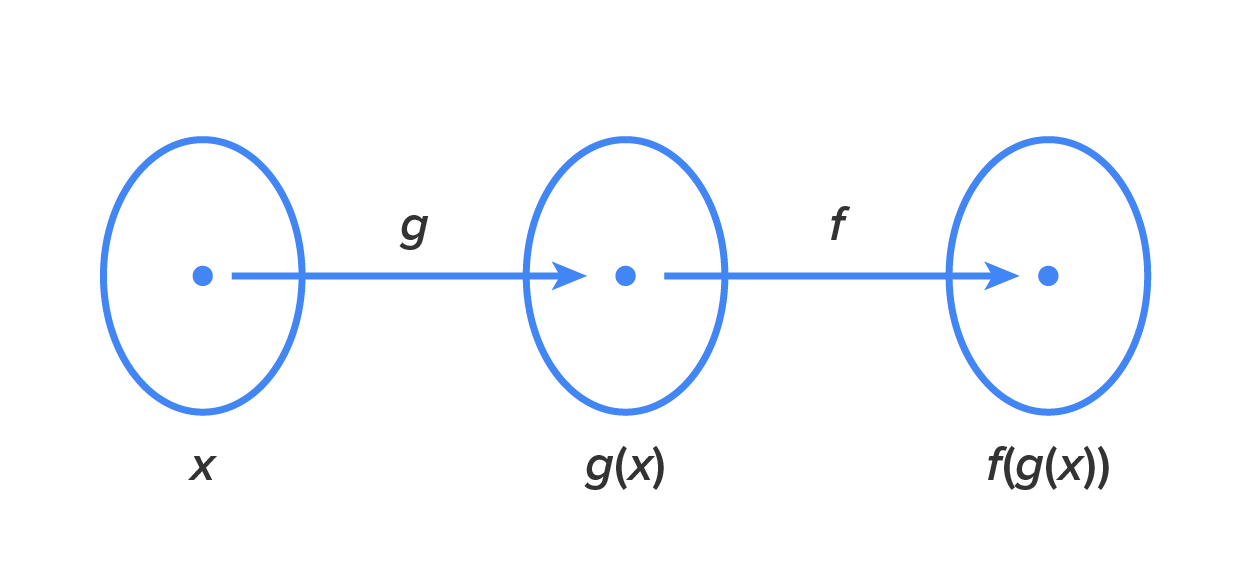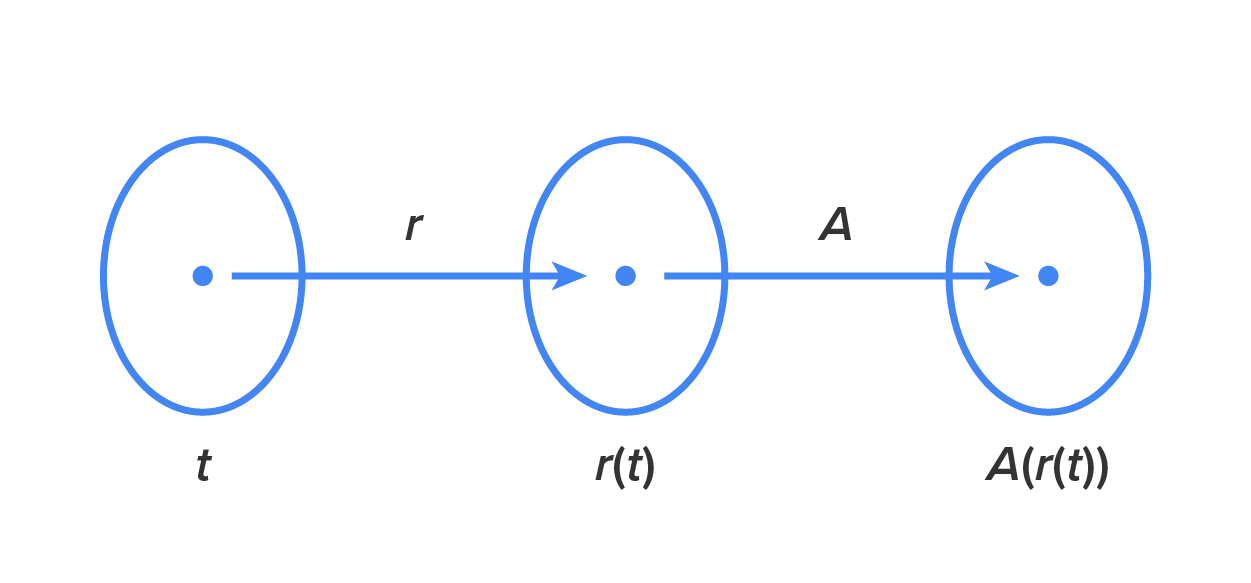Table of Contents |
Sometimes it is useful to use one function to get a result, then use that result in another function. This idea is called composition of functions.
Here is a picture to show how this works:

The original input is x, which is then substituted into  . Then,
. Then,  is input into function f, giving the result
is input into function f, giving the result 
The notation used to represent a composition of functions is  , which means
, which means  . The expression
. The expression  means “f composed with g.”
means “f composed with g.”
Using this notation, f is considered the outer function and g is the inner function. Notice that g is used first, then f is applied to the result. Therefore, the outer function is what is applied last. We will see how this works more closely in the next section when we evaluate compositions of functions.
 , it is a function that is obtained by substituting one function into another function.
, it is a function that is obtained by substituting one function into another function.EXAMPLE
Let and
and  . Find and simplify
. Find and simplify 

|
Rewrite using the definition of composition. |

|
Since  is the innermost expression, find that first: is the innermost expression, find that first: 
|

|
Evaluate  . .
|
 and
and 
It is also possible to substitute a function into itself. If you keep the definition in mind, this follows the same format.
EXAMPLE
Let . Find and simplify
. Find and simplify 

|
Rewrite using the definition of composition. |

|
Since  is the innermost expression, find that first: is the innermost expression, find that first: 
|

|
Evaluate  . .
|
The process for finding an expression for a composition is very similar to what we just did in the previous section, but this time there is no value to substitute first.
EXAMPLE
Let and
and  . Find and simplify
. Find and simplify 

|
Rewrite using the definition of composition. |

|
Substitute  . .
|
  
|
Evaluate the function and simplify. |
 and
and  .
.
 and
and  are not equal. In general, we can assume that
are not equal. In general, we can assume that 
 .
.
There are situations in which a composition can’t be simplified.
EXAMPLE
If and
and  , find an expression for
, find an expression for 

|
Rewrite using the definition of composition. |

|
Substitute  . .
|

|
Evaluate the function. |
 , so this is the final answer.
, so this is the final answer.
EXAMPLE
If and
and  , find an expression for
, find an expression for 

|
Rewrite using the definition of composition. |

|
Substitute  . .
|

|
Evaluate the function. |

 and
and  .
.
Given a composition of functions, it is important to be able to identify the inner and outer functions.
For example, each of these functions are compositions of other functions:

|

|

|
To decompose composite functions, identify the “inner” function first, then the “outer” function is apparent.
EXAMPLE
Consider the expression , which is the result of a composition of functions. How can we find functions
, which is the result of a composition of functions. How can we find functions  and
and  so that
so that  ?
?
 is the inside function, let
is the inside function, let  . Then, we have
. Then, we have 
 with a symbol, say “?”. We can write
with a symbol, say “?”. We can write  . As you can see, this tells us that
. As you can see, this tells us that 
 ,
,  and
and 

When a stone is dropped into a lake, a circular ripple forms and continues to get larger until it dissipates. After t seconds, the radius (in inches) of the ripple is  Recall also that the area of a circle with radius r is
Recall also that the area of a circle with radius r is 
EXAMPLE
Suppose we want to find a function for the area inside the ripple, but as a function of time, t. Here is how the functions work together:
 will give the area enclosed by the ripple after t seconds.
will give the area enclosed by the ripple after t seconds.

|
Use the definition of composition. |

|
Replace  with 4t. with 4t.
|

|
Evaluate the function. |

|
Simplify. |
EXAMPLE
The radius of a circle is given by the function where C is the circumference of the circle. Recall also that the area of a circle is
where C is the circumference of the circle. Recall also that the area of a circle is  Using this information, we can find
Using this information, we can find 

|
Rewrite using the definition. |

|
Replace  with with  . .
|

|
Evaluate the function. |

|
Apply the exponent. |

|
Remove the common factor of  . .
|
 , or
, or  , it means to substitute
, it means to substitute  into
into  . You learned how to compute compositions of functions, including both computing compositions for specific values and computing the expression for a composition of functions. You learned how to decompose composite functions by identifying the “inner” function first, after which the “outer” function is apparent. Finally, you explored applications of compositions in real-world situations.
. You learned how to compute compositions of functions, including both computing compositions for specific values and computing the expression for a composition of functions. You learned how to decompose composite functions by identifying the “inner” function first, after which the “outer” function is apparent. Finally, you explored applications of compositions in real-world situations.
SOURCE: THIS TUTORIAL HAS BEEN ADAPTED FROM CHAPTER 0 OF "CONTEMPORARY CALCULUS" BY DALE HOFFMAN. ACCESS FOR FREE AT WWW.CONTEMPORARYCALCULUS.COM. LICENSE: CREATIVE COMMONS ATTRIBUTION 3.0 UNITED STATES.